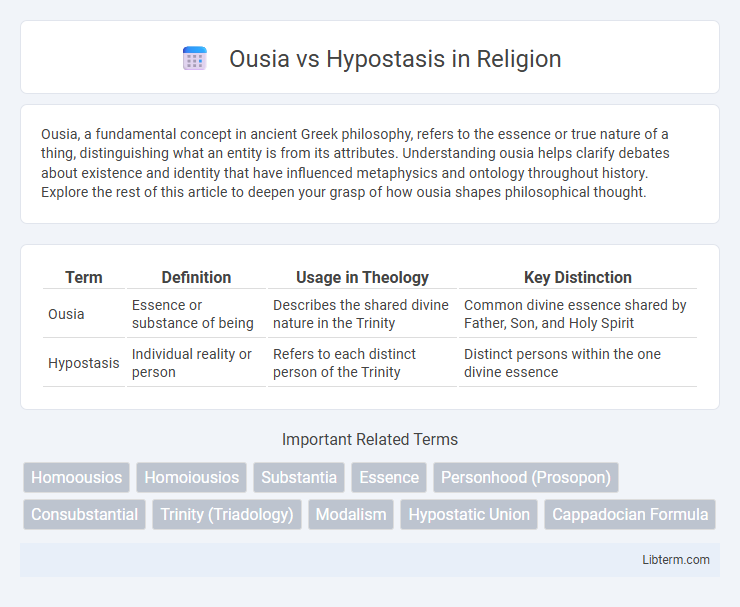Ousia, a fundamental concept in ancient Greek philosophy, refers to the essence or true nature of a thing, distinguishing what an entity is from its attributes. Understanding ousia helps clarify debates about existence and identity that have influenced metaphysics and ontology throughout history. Explore the rest of this article to deepen your grasp of how ousia shapes philosophical thought.
Table of Comparison
| Term | Definition | Usage in Theology | Key Distinction |
|---|---|---|---|
| Ousia | Essence or substance of being | Describes the shared divine nature in the Trinity | Common divine essence shared by Father, Son, and Holy Spirit |
| Hypostasis | Individual reality or person | Refers to each distinct person of the Trinity | Distinct persons within the one divine essence |
Defining Ousia: Essence in Philosophy
Ousia, originating from ancient Greek philosophy, defines the fundamental essence or substance that constitutes the true nature of an entity. In contrast to hypostasis, which refers to the underlying reality or individual existence of a substance, ousia emphasizes the common essence shared by all instances of a particular kind. Philosophers like Aristotle and later the Cappadocian Fathers developed ousia as the core concept to understand being and existence beyond mere appearance.
Understanding Hypostasis: The Underlying Reality
Hypostasis refers to the fundamental underlying reality or substance that supports and unifies all attributes within a being, distinct from ousia which denotes essence or existence in a broader sense. In theological and philosophical contexts, hypostasis is understood as the concrete individual reality that manifests the abstract essence or ousia, often used to describe the distinct persons in the Holy Trinity. Grasping hypostasis involves recognizing the unique, particular reality that exists beneath and informs the surface characteristics of an entity, providing a deeper understanding of identity and existence.
Historical Origins of Ousia and Hypostasis
Ousia and hypostasis have distinct historical origins rooted in ancient Greek philosophy and early Christian theology. Ousia, derived from Aristotle's metaphysics, originally denoted the essence or substance of a thing, representing what it fundamentally is. Hypostasis, emerging later in Christian theological discourse, particularly in the Cappadocian Fathers, refers to the individual reality or underlying personhood, especially in the context of the Trinity to distinguish the three persons within one divine essence.
Ousia vs Hypostasis: Semantic Differences
Ousia and Hypostasis differ primarily in their semantic scope within classical and theological contexts; Ousia refers to the essential substance or essence of a being, describing what something fundamentally is, whereas Hypostasis denotes an individual reality or personhood, emphasizing distinct existence within a shared essence. In Christian theology, especially in Trinitarian doctrine, Ousia represents the shared divine nature of the Father, Son, and Holy Spirit, while Hypostasis identifies each person as a specific, personal reality. This distinction highlights the conceptual separation between the universality of essence (Ousia) and the individuality of existence (Hypostasis).
Ousia in Platonic and Aristotelian Thought
Ousia in Platonic thought refers to the essential nature or form that defines the true reality of an object beyond its physical appearance, embodying the eternal and unchanging ideals that exist independently in the realm of Forms. Aristotle reinterprets ousia as substance, emphasizing individual entities as primary beings with essence that combines form and matter, grounding existence in concrete objects rather than abstract forms alone. This shift marks a transition from Plato's metaphysical idealism to Aristotle's empirical realism, focusing on the essence as the core reality of particular beings.
Hypostasis in Neoplatonism and Early Christianity
Hypostasis in Neoplatonism refers to the three fundamental realities: the One, the Intellect (Nous), and the Soul, which constitute different levels of being and existence. In Early Christianity, hypostasis denotes the underlying reality or personhood, particularly emphasized in the doctrine of the Trinity, where Father, Son, and Holy Spirit are distinct hypostases sharing one ousia (essence). This distinction highlights the theological importance of hypostasis as a concrete, individual existence within a unified divine nature.
Theological Implications: Trinity and Substance
Ousia and hypostasis are crucial theological terms in understanding the Trinity, where ousia refers to the shared divine substance or essence of the Father, Son, and Holy Spirit, while hypostasis denotes the distinct persons or realities within the Godhead. The differentiation emphasizes unity in substance without confusion of persons, preserving both monotheism and the distinct personal relationships central to Christian doctrine. This conceptual framework safeguards the balance between the co-equality of the three persons and the singular divine nature, forming the basis for orthodox Trinitarian theology.
Interpretations by Key Philosophers
Ousia and Hypostasis have been central to theological and philosophical debates, with Aristotle defining ousia as "essence" or "substance" and later Christian thinkers like the Cappadocian Fathers interpreting hypostasis as an individual reality or personhood within the Trinity. Gregory of Nyssa emphasized ousia as the divine nature shared by all three persons, while Basil the Great clarified hypostasis as the distinct personhood, maintaining unity without confusion. Thomas Aquinas further refined these concepts, equating ousia with substance and identifying hypostasis with individual existence, influencing scholastic understandings of the Trinity and metaphysics.
Modern Perspectives on Ousia and Hypostasis
Modern perspectives on ousia and hypostasis emphasize the distinction between essence and personhood within theological and philosophical contexts. Ousia refers to the underlying substance or essence of a being, while hypostasis denotes an individual instantiation or concrete reality of that essence. Contemporary scholars often analyze these concepts through the lens of Trinitarian theology, highlighting how ousia represents divine unity and hypostasis accounts for the distinct persons of the Godhead.
Conclusion: Significance in Contemporary Discourse
Ousia and Hypostasis remain crucial in contemporary theological and philosophical discourse for distinguishing between essence and individual existence within Trinitarian doctrine. Ousia represents the shared divine nature, while Hypostasis denotes the distinct persons of the Father, Son, and Holy Spirit, preserving unity without confusion. This distinction underpins modern debates on identity, personhood, and the nature of being in both religious and metaphysical contexts.
Ousia Infographic

 libterm.com
libterm.com